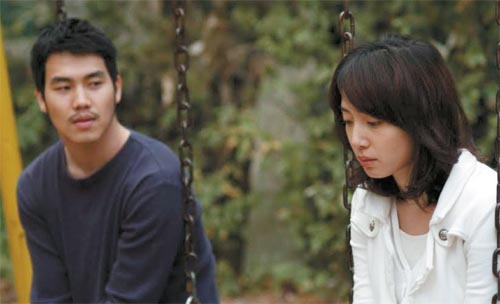Cardboard characters muddle their way through new indie film

Seon-il, left, and Jin-su talk in a scene from “The Way Back,” which is now playing in theaters nationwide. Provided by Smile Cine
Rookie director Steve Lee’s semi-autobiographical work, “The Way Back,” (2010) joins a handful of local, low-budget films released in recent months centering on young people and their arduous transition into adulthood.
While some of these films have been impressive, Lee’s portrayal of the pain of growing up and moving forward, while heartfelt, feels somewhat flat and the director’s passion seems larger than his grasp of cinematic dialogue and technique.
In the film, four twenty-something friends struggle to find their way in life after losing their friend Sang-yoon, who is murdered at the beginning of the film and is portrayed as the group’s smart, sensitive leader.
Sang-yoon’s best friend, Seon-il is hit the hardest by the death, as he feels guilty for having survived while Sang-yoon did not.
After the incident, the four try to escape their grim past and make a living for themselves somehow. The movie alludes to the fact that they are involved in some sort of a gang and shows the friends being tempted to return to their dangerous activities.
During the process, Seon-il finds love with Ji-su, who stumbles into the bar where Seon-il works. She is attractive and mysterious, and after some guitar-playing and wooing by Seon-il, the two become one.
But Ji-su also has a dark past in the form of an abusive boyfriend, and this eventually tears the couple apart.
Although the tone of the film feels sincere, it also feels inarticulate, almost like selected passages from the diary of an insecure schoolboy.
One reason for this is that the characters simply don’t feel complete.
Ji-su’s character in particular, was irritating to watch. From her all-too-typical entrance, which has her stumbling into a bar drunk and ordering around the shy Seon-il, to the ambiguous reason for her leaving Seon-il (she says she didn’t like the look in Seon-il’s eyes when he was defending her from her abusive ex-boyfriend), Ji-su comes off as a temperamental stereotype, yet is somehow portrayed as the catalyst for Seon-il changing his life and finding hope in love.
The friends and the roles they are supposed to play in the drama, as well as the way each deals with death, are too clear-cut and well planned.
Seon-il is clearly the delicate, thoughtful one of the bunch, reading “Catcher in the Rye” and trying to break free from his past and let things go, while Woo-sung is the tough kid, thinking that the only way to honor Sang-yoon is to get revenge.
The director tries to play with metaphors and one-liners but the dialogue comes off as rough and clumsy, as if the director had mixed together his favorite quotes from famous novels and sandwiched them into the characters’ lines. The film proves that while you can empathize with Holden Caulfield and believe that his story is your own, “Catcher in the Rye” is not a story that everyone can write.
The Way Back
Drama / Korean
90 min.
Now playing
By Cho Jae-eun [jainnie@joongang.co.kr]










with the Korea JoongAng Daily
To write comments, please log in to one of the accounts.
Standards Board Policy (0/250자)